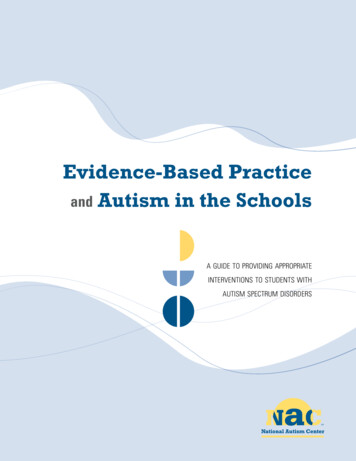
Transcription
Evidence-Based PracticeAutism in the Schoolsa guide to providing appropriateinterventions to students withautism spectrum disorders
Copyright 2009 National Autism CenterAll rights reserved.41 Pacella Park DriveRandolph, Massachusetts 02368No part of this publication may be reproduced without the prior written permission of the National Autism Center.To order copies of this book, contact the National Autism Center at 877-313-3833 or info@nationalautismcenter.org.
iii}Table of 1The Importance of Evidence-based Practice. . . . . . . . . . . . . . . . . . .1Outline of Chapters . . . . . . . . . . . . . . . . . . . . . . . . . . . . . . 3Chapter 1} Autism Spectrum Disorders. . . . . . . . . . . . . . . . . . . . 3Chapter 2} Research Findings. . . . . . . . . . . . . . . . . . . . . . . . 3Chapter 3} Professional Judgment. . . . . . . . . . . . . . . . . . . . . . 4Chapter 4} Values Preferences of Families . . . . . . . . . . . . . . . . . . . 6Chapter 5} Capacity . . . . . . . . . . . . . . . . . . . . . . . . . . . . 7Appendix} Findings and Conclusions of the National Standards Project. . . . . . . 9References110Understanding Autism Spectrum Disorders11Historical Perspective . . . . . . . . . . . . . . . . . . . . . . . . . . . .11Defining and Diagnosing Autism Spectrum Disorders. . . . . . . . . . . . . . . 13Misperceptions About ASD . . . . . . . . . . . . . . . . . . . . . . . . . . 14Autism Today: Current Facts. . . . . . . . . . . . . . . . . . . . . . . . . . 15What Does Autism Look Like?. . . . . . . . . . . . . . . . . . . . . . . . 16Autistic Disorder . . . . . . . . . . . . . . . . . . . . . . . . . . . . 16Asperger’s Disorder . . . . . . . . . . . . . . . . . . . . . . . . . . 20Pervasive Developmental Disorder – Not Otherwise Specified. . . . . . . . 22Rett’s Disorder. . . . . . . . . . . . . . . . . . . . . . . . . . . . . 23Childhood Disintegrative Disorder . . . . . . . . . . . . . . . . . . . . 24Autism Across the Lifespan . . . . . . . . . . . . . . . . . . . . . . . . . . 25Differential Diagnoses and Co-morbid Conditions . . . . . . . . . . . . . . . . 27Frequently Occurring Diagnoses and Conditions . . . . . . . . . . . . . . . 29Anxiety and Depression. . . . . . . . . . . . . . . . . . . . . . . . . 29Attention Deficit Hyperactivity Disorder . . . . . . . . . . . . . . . . . . 30Obsessive-Compulsive Disorder. . . . . . . . . . . . . . . . . . . . . 31Psychotic Disorders. . . . . . . . . . . . . . . . . . . . . . . . . .32Bipolar Disorder and Oppositional Defiant Disorder . . . . . . . . . . . .33Final Considerations . . . . . . . . . . . . . . . . . . . . . . . . . . . . . 34Recommended Readings35References36
{ iv2Research Findings of the National Standards Project37Established Treatments. . . . . . . . . . . . . . . . . . . . . . . . . . . . 39Antecedent Package . . . . . . . . . . . . . . . . . . . . . . . . . . .40Behavioral Package . . . . . . . . . . . . . . . . . . . . . . . . . . . . 42Comprehensive Behavioral Treatment for Young Children . . . . . . . . . . .46Joint Attention Intervention. . . . . . . . . . . . . . . . . . . . . . . . . 48Modeling. . . . . . . . . . . . . . . . . . . . . . . . . . . . . . . .50Naturalistic Teaching Strategies. . . . . . . . . . . . . . . . . . . . . . . 52Peer Training Package. . . . . . . . . . . . . . . . . . . . . . . . . . . 55Pivotal Response Treatment . . . . . . . . . . . . . . . . . . . . . . . .58Schedules. . . . . . . . . . . . . . . . . . . . . . . . . . . . . . . . 61Self-management . . . . . . . . . . . . . . . . . . . . . . . . . . . . . 63Story-based Intervention Package . . . . . . . . . . . . . . . . . . . . . . 66Final Considerations . . . . . . . . . . . . . . . . . . . . . . . . . . . . . 683Recommended Readings69References70Professional Judgment and Data-based Decision Making73Integrating Information About the Student . . . . . . . . . . . . . . . . . . . . 74Awareness of Additional and New Research Findings . . . . . . . . . . . . . . . 75Data Collection. . . . . . . . . . . . . . . . . . . . . . . . . . . . . . .78Setting Goals and Defining Target Behaviors. . . . . . . . . . . . . . . . . . . 80Setting Goals. . . . . . . . . . . . . . . . . . . . . . . . . . . . . . . 80Defining Target Behaviors . . . . . . . . . . . . . . . . . . . . . . . . . 82Procedures for Collecting Data . . . . . . . . . . . . . . . . . . . . . . . .83Frequency Data . . . . . . . . . . . . . . . . . . . . . . . . . . . . . . 83Time Sampling . . . . . . . . . . . . . . . . . . . . . . . . . . . . . . 85Duration. . . . . . . . . . . . . . . . . . . . . . . . . . . . . . . . . 88Latency . . . . . . . . . . . . . . . . . . . . . . . . . . . . . . . . . 88Additional Data Collection Considerations . . . . . . . . . . . . . . . . . . 89Using Data to Establish Baselines. . . . . . . . . . . . . . . . . . . . . . . . 90Intervention Data . . . . . . . . . . . . . . . . . . . . . . . . . . . . . .91Graphing Data. . . . . . . . . . . . . . . . . . . . . . . . . . . . . . . . 92
v}Visual Analysis of Data. . . . . . . . . . . . . . . . . . . . . . . . . . . . 94Calculating the Percentage of Overlapping Data Points. . . . . . . . . . . . . 98Challenges in Visual Analysis . . . . . . . . . . . . . . . . . . . . . . . . . 102Is the Intervention Effective?. . . . . . . . . . . . . . . . . . . . . . . . . 1054Final Considerations . . . . . . . . . . . . . . . . . . . . . . . . . . . .108Recommended Readings110References110Incorporating Family Preferences and ValuesInto the Educational Process111Supporting Family Involvement in Evidence-based Practice. . . . . . . . . . . . 113Cultural Variables. . . . . . . . . . . . . . . . . . . . . . . . . . . .114Socioeconomic Status. . . . . . . . . . . . . . . . . . . . . . . . . . . 116Employment and Family Issues. . . . . . . . . . . . . . . . . . . . . . . 117Severity of Symptom Presentation. . . . . . . . . . . . . . . . . . . . .118School Factors. . . . . . . . . . . . . . . . . . . . . . . . . . . . . . 118Social Validity . . . . . . . . . . . . . . . . . . . . . . . . . . . . . . .119Recommendations for Incorporating Family Preferences and Values. . . . . . . .120Data Collection. . . . . . . . . . . . . . . . . . . . . . . . . . . . .121Ongoing Communication . . . . . . . . . . . . . . . . . . . . . . . . . 131Parent Education and Training. . . . . . . . . . . . . . . . . . . . . . . 131Tackle Barriers to Family Participation. . . . . . . . . . . . . . . . . . .133Inform Families of Choices and Options. . . . . . . . . . . . . . . . . . . 134Address Conflicting Views . . . . . . . . . . . . . . . . . . . . . . . .135Establish Appropriate Family Supports . . . . . . . . . . . . . . . . . . . 136Support Parents in Generalizing Skills. . . . . . . . . . . . . . . . . . . . 137Final Considerations . . . . . . . . . . . . . . . . . . . . . . . . . . . .138Case Example . . . . . . . . . . . . . . . . . . . . . . . . . . . . . . 139Recommended Readings142References143
{ vi5Building and Sustaining Capacity to Deliver Treatmentsthat Work145Producing Systemic Change . . . . . . . . . . . . . . . . . . . . . . . . . 148Step 1: Establish the Planning Team . . . . . . . . . . . . . . . . . . . .149Step 2: Problem Clarification and Needs Assessment . . . . . . . . . . . . . 154Step 3: Evaluating Outcomes. . . . . . . . . . . . . . . . . . . . . . .168Step 4: Developing a Training Plan. . . . . . . . . . . . . . . . . . . . . 172Step 5: Sustainability. . . . . . . . . . . . . . . . . . . . . . . . . . . 174Unique Considerations . . . . . . . . . . . . . . . . . . . . . . . . . . 177Case Study: Developing Capacity – Elizabeth Public School District . . . . . . . . 178Final Considerations . . . . . . . . . . . . . . . . . . . . . . . . . . . .180Recommended Readings181References181AppendixFindings and Conclusions of the National Standards Project182
vii}AcknowledgementsWe are grateful to the many individuals and organizations who supported the development of this manual.Production and distribution have been made possible through a generous gift from the American Legion ChildWelfare Foundation, Inc. Thanks to their support, the National Autism Center has delivered thousands of free copiesof the manual to educators across the country serving students with Autism Spectrum Disorders.We also wish to express our gratitude to the Niel M. Wreidt 2003 Revocable Trust for the financial support thatallowed us to develop this manual.This manual could not have been developed without the contributions of its primary authors. We thank: Laura Fisher,Psy.D., for her comprehensive examination of Autism Spectrum Disorders (Chapter 1); Dipti Mudgal, Ph.D., BCBA, forher extensive review of interventions that have solid research support (Chapter 2); Hanna Rue, Ph.D., for her thoughtful examination of professional judgment and data-based decision making (Chapter 3); Melissa Hunter, Ph.D., forher sensitive consideration of strategies for incorporating family input into decision making (Chapter 4); and SusanWilczynski, Ph.D., BCBA, for her analysis of methods of producing systemic change to enhance evidence-basedpractice in the schools (Chapter 5). Dr. Wilczynski also served as a secondary author for Chapters 1–4.Finally, we appreciate the in-kind support provided by May Institute. Without the support of its talented communications team, this manual would be visually unappealing and hard to read!Susan M. Wilczynski, Ph.D., BCBAExecutive DirectorEileen G. Pollack, M.A.Director of Publications and Media RelationsNational Autism CenterEditorNational Autism CenterEditor
{ForwardThe National Autism Center is dedicated to serving children and adolescents with Autism Spectrum Disorders (ASD)by providing reliable information, promoting best practices, and offering comprehensive resources for families,practitioners, and communities. The National Autism Center initiated the National Standards Project to conduct acomprehensive review and evaluation of existing research into treatments for children and adolescents with ASD.The resulting National Standards Project Report was published in 2009 to share these findings. (See Appendix for theFindings and Conclusions report.)We offer this educator manual to help fulfill the National Autism Center’s mission to advocate for evidence-basedpractice, and to assist front-line interventionists as they select and implement the most effective research-supportedtreatments for ASD.viii
IntroductionThe Importance of Evidence-basedPracticeThe evidence-based practice movement began in medicine in the 1990s.While research had led to advancements in the medical treatment ofpatients, physicians were not always aware of these advancements. In somecases, physicians continued to use medications or medical procedures thatwere no longer considered appropriate. In other cases, physicians wereunaware of newer medications or medical procedures that would lead to better outcomes for their patients.Physicians are not alone in their need to stay current with advances in research andbest practices in their fields of expertise. A broad range of health and school professionals also face this problem. While keeping up with research is challenging, we areall obligated to do so in order to provide the most appropriate and effective services tothe students we serve. In fact, federal legislation regulating the provision of services inschools is filled with references about the need to employ research-supported treatments (Individuals with Disabilities Education Improvement Act, 2004; No Child LeftBehind, 2002).The National Autism Center has developed this manual as a means of promotingevidence-based practice for Autism Spectrum Disorders (ASD) in the schools. Why?Because we know that evidence-based practice is in the best interest of the studentand that it is most likely to produce positive outcomes with this population. The information presented herein is meant for all “front-line” interventionists who work inschool settings.Although research findings are essential, they are not the only component ofevidence-based practice. Evidence-based practice requires the integration of researchfindings with other critical factors.1}Evidence-based Practice and Autism in the Schools
These factors include: Professional judgment and data-based decision making Values and preferences of families, including the student on the autism spectrumwhenever feasible Capacity to accurately implement interventionsThis definition of evidence-based practice is applied to school settings throughout this document. Evidence-based practice is complex and requires both ongoingcommunication and respectful interactions among all stakeholders. Even when alist of effective treatments is identified, collaboration is the key to achieving the bestoutcomes. To that end, we have provided examples involving a broad range of professionals and support staff throughout the manual to illustrate the points we make.We have organized this manual in a progressive fashion. We recommend beginning with the chapter describing ASD and ending with the chapter on building capacity.Although some chapters may be perceived as more relevant to some school personnel(e.g., an administrator may be drawn to the chapter on building capacity), we believeit is important for all school personnel to be familiar with all factors that contribute toevidence-based practice for ASD. For example, we anticipate that even experiencedprofessionals will benefit from the discussion about complex diagnostic concerns forthis population.About our Terminology:Our goal has been to make this manual as user-friendly as possible. Therefore, we have tried whenever possible to avoid using jargon, and we have defined terms when necessary.It is important to clarify our use of terminology regarding school personnel in these pages. Weoften use the terms “educators,” “front-line interventionists,” “school staff,” and “school personnel” interchangeably. Although the examples we provide include paraprofessionals, teachers, andsupport service staff, we often apply the more generic terms because any of these individuals maybe represented in the examples.National Autism Center{2
Outline of ChaptersChapter 1} Autism Spectrum DisordersMost readers of this manual will already have some understanding of AutismSpectrum Disorders (ASD). But autism and related disorders are complex, and we allbenefit from considering just how broad the spectrum can be. Experience with youngstudents with severe autism is not the same as understanding adolescents withAsperger’s Disorder. Further, an alarming number of students with ASD are misdiagnosed with alternate disorders for years before receiving the correct diagnosis. Finally,some students on the autism spectrum should also be diagnosed with one or moreadditional disorders. Correct diagnosis is essential for developing interventions that willhelp your students reach their potential.We begin our manual on Evidence-based Practice and Autism in the Schools byreviewing the defining and associated features of ASD. In Chapter 1, we also considervariables that should be examined when making differential diagnoses for individualsdemonstrating symptoms often associated with ASD.Chapter 2} Research FindingsEveryone wants to use treatments that work. Yet identifying effective interventionscan be challenging. Consider this: treatments for which no well-controlled researchhas been published are often described as “evidence-based practice.” This can make itextremely difficult to know which treatments have research showing they are effective,and which do not.We recognize that translating research into practice is complicated. That is why wehave created this manual as a tool to help you know which interventions have strongevidence of effectiveness. The National Autism Center’s National Standards Projectidentifies the level of research support available for treatments often used with schoolaged individuals on the autism spectrum.In the Findings and Conclusions report of the National Standards Project, the term“Established Treatments” is applied to any interventions with sufficient research toshow they are effective. Eleven Established Treatments are identified in Chapter 2. Wedescribe each one detail and provide illustrative examples to clarify the uses of theseinterventions.3}Evidence-based Practice and Autism in the Schools
Chapter 3} Professional JudgmentEvidence-based practice is a complex process that requires the knowledge andskills of well-trained professionals. Therefore, your professional judgment is extremelyimportant in this process. In your work, you are presented with a broad array of treatment options available to support students on the autism spectrum. Even if you restrictyour choices exclusively to treatments that have produced favorable outcomes inresearch, you will need to select among the field of 11 identified in the Findings andConclusions report.Your experience working with a specific child with ASD, your understanding of interventions that have been effective in the past, and your awareness of the environmentin which the treatment would be implemented are all critical to helping you identifywhich of these 11 Established Treatments might be most useful.Since research is ongoing and best practices evolve, your professional judgmentextends to your awareness of additional research support beyond those studiesreviewed in the Findings and Conclusions report.For example: The National Standards Project reviewed articles published before the fall of 2007.We are happy to report that additional research has been conducted and publishedsince that date. As a result, you may be aware of more recent, well-controlled studies that strongly suggest more research support for an intervention identified asan “Emerging Treatment” in the Findings and Conclusions report. Armed with thisknowledge, your judgment may lead you to place that treatment under consideration along with any of the Established Treatments. There may be some symptoms that co-occur with ASD that are not associatedwith any Established Treatments. For example, some adolescents with Asperger’sDisorder may experience co-morbid psychiatric disorders (e.g., anxiety disorders ordepression). There are no treatments specifically addressing anxiety and depressionthat fall into the Established Treatments category in the Findings and Conclusionsreport. However, there are treatments for anxiety and depression for individualswho are not diagnosed with ASD. Your awareness of this important literature shouldabsolutely assist in treatment selection.National Autism Center{4
Like other evidence-based practice guidelines, the National Standards Projectfollowed strict inclusionary and exclusionary criteria. How did this affect theoutcomes? Perhaps Facilitated Communication can serve as an example. TheNational Standards Project excluded alarge number of studies on the treatmentof Facilitated Communication becausethey involved {a} adults 22 years of age orolder, or {b} individuals with infrequentlyoccurring co-morbid conditions, or {c} adultfacilitators (as opposed to the individualswith ASD). Although Facilitated Communication was classified as an “UnestablishedTreatment” in the Findings and Conclusions report, as a professional, you may beaware that a large number of professionalorganizations have developed resolutionsadvising against the use of FacilitatedCommunication. These resolutions areoften related to concerns regarding“immediate threats to the individual civiland human rights of the person withautism ” (American Psychological Association, 1994). Your professional judgmentis likely to play a role in treatment selectionin this case, as one example.Professional judgment can also beimportant when considering an interventionidentified as an Established Treatment in theFindings and Conclusions report. You may5}seek out more detailed information in theliterature to help guide appropriate treatmentselection.For example, let’s say a young boy withASD has a history of becoming promptdependent. You might select “Schedules” tohelp him independently move from one taskto another. Then you might select promptsthat are easier to fade as opposed to promptsthat are more difficult to fade. Althoughschedules and prompting procedures are eachidentified as an Established Treatment in theFindings and Conclusions report, your professional judgment as a front-line interventionistis essential in structuring environments thatbest promote independent learning.Initial treatment selection is only one partof the process of engaging in evidence-basedpractice. In order to be confident that an intervention is effective with a specific student,it is necessary to collect data. These datashould be collected in a way that allows youto determine if the intervention is effective.Data will also let you quickly make changes totreatments if an intervention is not producingdesired improvements for your students.Chapter 3 offers a more complete discussion of the importance of professionaljudgment and the role data collection plays inthis process.Evidence-based Practice and Autism in the Schools
Chapter 4} Values and Preferences of FamiliesFamily members and/or the individual with ASD should participate in interventionselection to maximize outcomes. The annual review of the Individualized EducationalPlan (IEP) serves as one opportunity to discuss the comprehensive goals to be met sothat the student with ASD can reach his academic potential and participate in meaningful ways in the community. But setting these goals is only the starting point in theconversation that should occur between family members, the student with ASD, andschool professionals. To achieve the best outcomes, efforts should be made to buildconsensus about the treatment approaches used to meet the IEP goals.There are several ways in which treatment selection is undermined if the input offamily members and/or the individual with ASD is not sought, or is ignored. For example, family members often seek additional supports beyond those offered within schoolsystems. Behavior specialists, speech-language pathologists, occupational or physicaltherapists, and other professionals may provide therapeutic services outside the schoolsetting. These professionals may have already attempted to implement any numberof treatments that did not produce favorable outcomes. Without seeking the family’sinput, school professionals may select treatments that have already been shown tobe ineffective with a specific child. (See Chapter 5 for discussion of the importance ofdata-based decision making as a component of professional judgment.)It is also important to understand how the cultural values and preferences of a family may conflict with the implementation of one treatment or another. For example, incertain cultures, it is not appropriate for children to make direct eye contact with adults.Despite the fact that teaching a child to make and maintain eye contact is often one ofthe first skills addressed in Comprehensive Behavioral Treatment for Young Children,family members may object to this skill being taught. Often, a compromise might bereached if an open and honest dialogue occurs. (For example, the child will make eyecontact with adults in the school setting, but no efforts will be made to teach her tomake eye contact in other settings.) Conversely, the team may make the decision toNational Autism Center{6
begin the intervention without directlyteaching eye contact and then set a dateto reconsider the issue if the data showthe child is making little progress.To expand your use of strategies forincorporating the values and preferencesof families, we encourage you to readChapter 4.There are many barriers that couldundermine parental participation in theeducational process. These barriers donot have to be insurmountable if schoolsseek to identify and address them. Forexample, additional supports should beprovided for families facing challengesassociated with transportation, childcare, language barriers, or difficult workschedules. We offer strategies for gathering information from families that willallow you to create a positive and inclusive environment for the entire family.Chapter 5} CapacityThe individual with ASD is a member of the family, and his values andpreferences must also be taken intoconsideration whenever feasible. Forexample, an adolescent boy who wouldbenefit from an improvement in hissocial relationships might select a lessintrusive intervention (such as SocialStories ) over a more intrusive procedure that sets him apart (such as PeerTraining Package). Certainly, his opinionis relevant in selecting between thesetwo treatments, and will likely have animpact on outcome.7}Evidence-based Practice and Autism in the SchoolsLet’s say your school makes thedecision to implement one of the interventions identified as an EstablishedTreatment in the Findings andConclusions report. Does this automatically mean you are about to engage inevidence-based practice for ASD? Wewould argue that you are not — that is,not until you have built the capacity toimplement the intervention with a highdegree of treatment integrity. Further,even after you have begun to implementthe intervention correctly, you mustensure the intervention is sustainable.We already know that selectingtreatments should involve {a} an understanding of research findings, {b} inputfrom qualified professionals, and {c}input from families, including the studentwhenever possible. However, when yourschool makes decisions about implementing an intervention, it’s importantto ask, “If we feel strongly enoughthat this intervention should be implemented with one child, should it also be
implemented with more children with ASDwho exhibit similar needs?” When selecting one of the Established Treatments, theanswer will almost always be “yes.”Selecting treatments for more than onechild often involves making systemic changeswithin the school system. This typically beginswith problem clarification. You need to answerthree questions: What do we need to accomplish? Who is responsible for planning for thenew treatment? Who will evaluate the effectiveness of the new treatment?When decisions are made for a specificchild, these questions are often answered bya small team of individuals who work with orcare for the child. When decisions are madefor a school system, it is important to includea broader range of professionals, as well asfamilies, into the decision-making process.Paraprofessionals, other support staff, psychological services, allied health professionals,and administration — in addition to teachers — should all be included in the planningand evaluation of any new treatment that isbeing adopted broadly (across students andsettings).The planning and evaluation team will alsoneed to make decisions about the scale ofthe change (e.g., a classroom, a grade level,or a school) and the groups for which thenew treatment should be considered (e.g., Allchildren? All children with ASD? Children in aparticular age group or developmental level?).Next, the team must consider all aspectsof the system that may be affected by thischange. For example, will the curriculumneed to be changed? What are the settings inwhich the treatment will be delivered? Whowill deliver the treatment?Before beginning training, a needsassessment should be conducted toidentify the following barriers: Differences between the existing and proposed interventions Additional time required to implement newtreatments Treatment acceptability History of treatment delivery Organizational climateThe planning and evaluation team’sresponsibilities do not end with the needsassessment. They must also operationallydefine the intended outcomes. This mayinvolve specifying the goals for a classroom,grade level, and/or school system. In additionto clearly defining the goals for the affectedsystem, the goals for the target populationNational Autism Center{8
must be defined so that they are specific, observable, and measurable. Both immediate and long-term goals must be considered.Finally, the planning and evaluation team must develop a writte
This definition of evidence-based practice is applied to school settings through-out this document. Evidence-based practice is complex and requires both ongoing communication and respectful interactions among all stakeholders. Even when a list of effective treatments is identified,

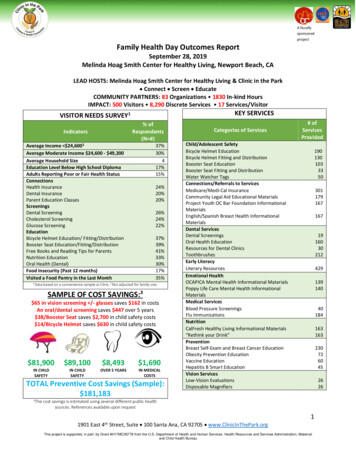
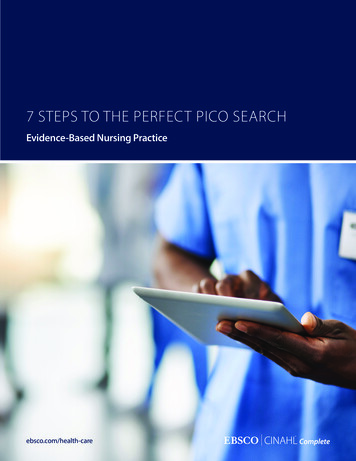

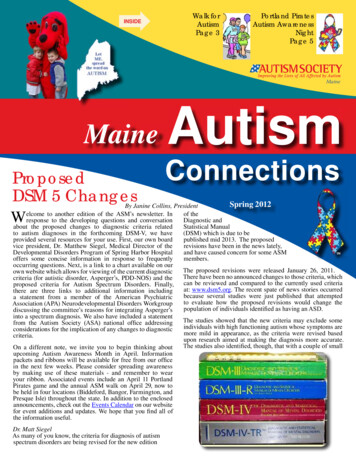
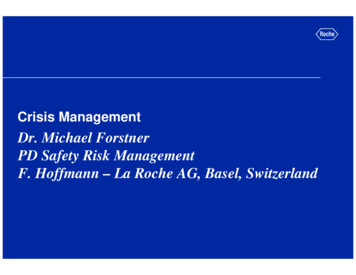
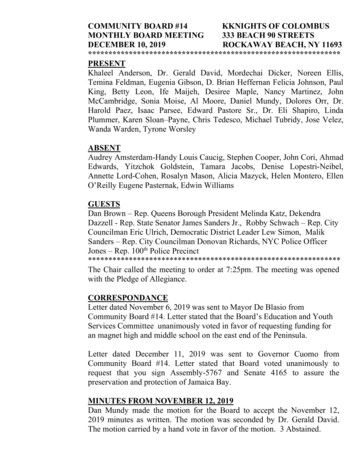
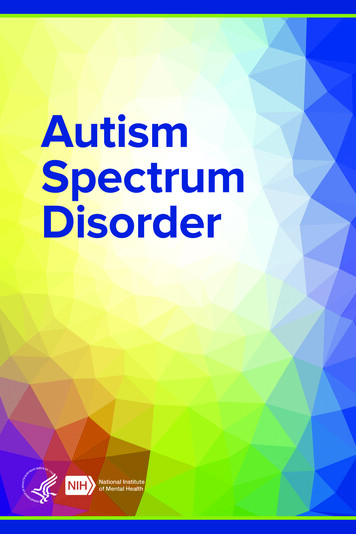
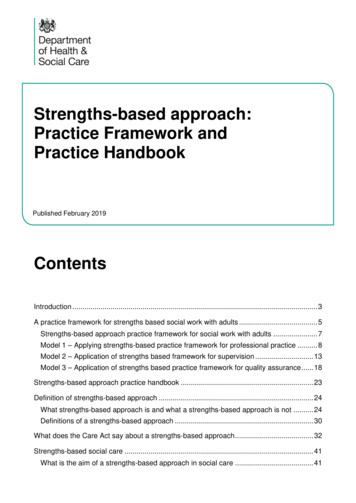
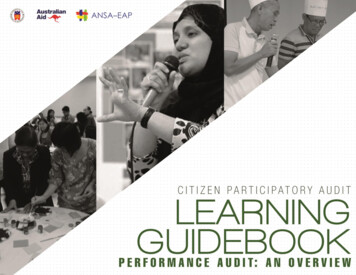
![project2 Encase.pptx [Read-Only]](/img/12/project2-encase.jpg)